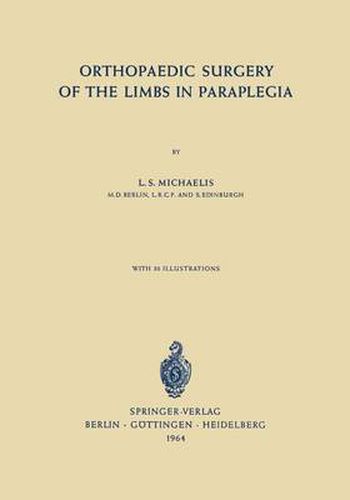Readings Newsletter
Become a Readings Member to make your shopping experience even easier.
Sign in or sign up for free!
You’re not far away from qualifying for FREE standard shipping within Australia
You’ve qualified for FREE standard shipping within Australia
The cart is loading…






This title is printed to order. This book may have been self-published. If so, we cannot guarantee the quality of the content. In the main most books will have gone through the editing process however some may not. We therefore suggest that you be aware of this before ordering this book. If in doubt check either the author or publisher’s details as we are unable to accept any returns unless they are faulty. Please contact us if you have any questions.
In the rehabilitation of paraplegics reconstructive and corrective operations play a not unimportant part. Their chief value lies in assisting conservative measures as a means of speeding up the social reintegration of these severely disabled people. Furthermore, in certain groups of paraplegics, these operations establish the very basis for a successful rehabilitation. This applies in the first place to that group of spastic and flaccid paraplegics where inadequate early treat ment has led to severe tendon and joint contractures, secondly to that group of paraplegics who develop para-articular ossification of so far unexplained aetiology. The complex problems we meet in the rehabilitation of paraplegics demand exact indications for reconstructive and corrective operations. To fit them suitably into the overall-plan of treatment demands proper knowledge of the neurophysiology of spinal man. In almost twenty years a certain system of reconstructive and corrective operations has been developed at the National Spinal Injuries Centre, Stoke Mandeville. Dr. MICHAELIS, who has acquired considerable experience in the techniques of this operative and post-operative treatment, undertook the commen dable task of presenting these in a monograph. The special value of this publication lies in the description not only of the successes but also of the failures of operative treatment. I hope that this monograph will be a valuable help and guide for all doctors, whose responsible task and goal it is to achieve the social reintegration of the paraplegic.
$9.00 standard shipping within Australia
FREE standard shipping within Australia for orders over $100.00
Express & International shipping calculated at checkout
This title is printed to order. This book may have been self-published. If so, we cannot guarantee the quality of the content. In the main most books will have gone through the editing process however some may not. We therefore suggest that you be aware of this before ordering this book. If in doubt check either the author or publisher’s details as we are unable to accept any returns unless they are faulty. Please contact us if you have any questions.
In the rehabilitation of paraplegics reconstructive and corrective operations play a not unimportant part. Their chief value lies in assisting conservative measures as a means of speeding up the social reintegration of these severely disabled people. Furthermore, in certain groups of paraplegics, these operations establish the very basis for a successful rehabilitation. This applies in the first place to that group of spastic and flaccid paraplegics where inadequate early treat ment has led to severe tendon and joint contractures, secondly to that group of paraplegics who develop para-articular ossification of so far unexplained aetiology. The complex problems we meet in the rehabilitation of paraplegics demand exact indications for reconstructive and corrective operations. To fit them suitably into the overall-plan of treatment demands proper knowledge of the neurophysiology of spinal man. In almost twenty years a certain system of reconstructive and corrective operations has been developed at the National Spinal Injuries Centre, Stoke Mandeville. Dr. MICHAELIS, who has acquired considerable experience in the techniques of this operative and post-operative treatment, undertook the commen dable task of presenting these in a monograph. The special value of this publication lies in the description not only of the successes but also of the failures of operative treatment. I hope that this monograph will be a valuable help and guide for all doctors, whose responsible task and goal it is to achieve the social reintegration of the paraplegic.